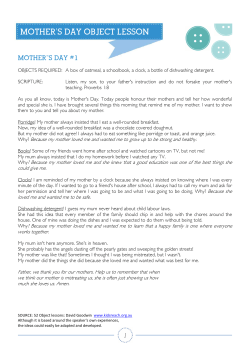
Sample Questions for Evaluation 2 – Dr. Green
Sample Questions for Evaluation 2 – Dr. Green 1. Gender identity refers to: A) the set of expected behaviors for males and for females. B) one's biological sex. C) how masculine a boy is or how feminine a girl is. D) the sense of being male or female. 2. According to Piaget, accommodation refers to: A) adjusting current schemas in order to make sense of new experiences. B) developmental changes in a child's behavior that facilitate social acceptance by family and peers. C) parental efforts to include new children in the existing family structure. D) incorporating new experiences into existing schemas. 3. Social learning theorists emphasize that: A) children will not learn gender-typed behaviors if the same-sex parent is absent from the home. B) observation and imitation play a crucial role in the gender-typing process. C) children will exhibit only those gender-typed behaviors for which they have been directly rewarded. D) all of these answers are correct. 4. Cognition refers to: A) any process that facilitates the physical development of the brain. B) an emotional tie linking one person with another. C) any process of change that accompanies maturation. D) the mental activities associated with thinking, knowing, remembering, and communicating. 5. Brittla spends a lot of money on cosmetics and expensive clothing in order to attract a desirable mate. According to evolutionary psychologists, Brittla's behavior is a product of: A) genetic predispositions. B) her individuality. C) her culture. D) gender. 6. The Harlows observed that most monkeys raised in total isolation: A) showed slower social development but more rapid cognitive development. B) were totally apathetic and indifferent to the first monkeys they encountered. C) showed no lasting adverse effects when placed in a socially enriched environment. D) were incapable of mating upon reaching sexual maturity. Page 1 7. A child's temperament is likely to be: A) a product of parenting style. B) a reflection of his or her gender. C) stable over time. D) difficult to observe. 8. Mrs. Pearson cut Judy's hot dog into eight pieces and Sylvia's into six pieces. Sylvia cried because she felt she wasn't getting as much hot dog as Judy. Piaget would say that Sylvia doesn't understand the principle of: A) conservation. B) accommodation. C) object permanence. D) egocentrism. 9. Studies of monkeys raised with artificial mothers suggest that mother-infant emotional bonds result primarily from mothers providing infants with: A) the opportunity to explore. B) adequate nourishment. C) permissive parenting. D) body contact. 10. Erikson would have suggested that adolescents can most effectively develop a sense of identity by: A) investigating the personal suitability of various occupational and social roles. B) adopting whatever values and expectations their parents recommend. C) severing the emotional ties between themselves and their childhood friends. D) seeking a lifelong romantic relationship. 11. According to Kohlberg, morality based on the avoidance of punishment and the attainment of concrete rewards represents a ________ morality. A) concrete operational B) postconventional C) preconventional D) conventional 12. A teratogen is a(n): A) unborn child with one or more physical defects or abnormalities. B) substance that can cross the placental barrier and harm an unborn child. C) fertilized egg that undergoes rapid cell division. D) chromosomal abnormality. Page 2 13. For children from impoverished environments, stimulating educational experiences during early childhood are most likely to: A) have no discernable effect on subsequent academic performance. B) prevent the degeneration of activated connections between neurons. C) decrease their emotional attachment to their own parents. D) facilitate the development of collectivism. 14. Piaget was convinced that the mind of a child: A) is heavily dependent on the child's personality. B) is like a blank slate at birth. C) is not heavily influenced by maturation. D) develops through a series of stages. 15. Newborns have been observed to show the greatest visual interest in a: A) bull's-eye pattern. B) rectangular shape. C) facelike image. D) circular shape. 16. During the months when there is a large amount of pollen in the air, your hay fever severely affects your sense of smell. At the same time your food all seems to taste the same. This illustrates the importance of: a) sensory interaction. b) parallel processing. c) serial processing. d) sensory adaptation. 17. Infants who were exposed to the visual cliff: a) tried to climb up the cliff if their mothers were at the top. b) gave no evidence that they could perceive depth. c) refused to cross over the “deep” side to their mothers. d) eagerly crossed to their mothers by means of the “bridge” provided. Page 3 18. The tendency to hear the steady drip of a leaky sink faucet as if it were a repeating rhythm of two or more beats best illustrates: a) interposition. b) perceptual organization. c) relative luminance. d) perceptual adaptation. 19. A subliminal message is one that is presented: a) below one's absolute threshold for awareness. b) in a manner that is unconsciously persuasive. c) with very soft background music. d) repetitiously. 20. The process by which our sensory systems transform stimulus energies into neural messages is called: a) priming. b) sensory adaptation. c) transduction. d) sensory interaction. Page 4 Answer Key 1. 2. 3. 4. 5. 6. 7. 8. 9. 10. 11. 12. 13. 14. 15. 16. 17. 18. 19. 20. D A B D A D C A D A C B B D C A C B A C Page 5
© Copyright 2024





















